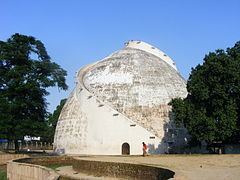Current tenants Bihar Government Client Bihar government Height 29 m Owner Government of Bihar | Completed 20 July 1786 Landlord Bihar Government Opened 20 July 1786 | |
 | ||
Similar Sanjay Gandhi Jaivik Ud, Agam Kuan, Mahavir Mandir, Mahatma Gandhi Setu, Srikrishna Science Centre | ||
The Golghar or Gol Ghar (गोलघर), ("Round house") is a large granary located to the west of the Gandhi Maidan in Patna, capital of Bihar state, India.
Contents
Map of Golghar, Raja Ji Salai, Chajju Bagh, Patna, Bihar 800001
History
According to a contemporary inscription at its base, the Golghar was intended to be just the first of a series of these huge grain stores. In the end, however, no others were ever built. The granary was "part of a general plan … for the perpetual prevention of famine in these provinces" ordered in 1784 by Warren Hastings, the then Governor-General of India.
The beehive-shaped structure was designed by Captain John Garstin of the Bengal Engineers, part of the East India Company's Bengal Army. Construction was completed on 20 July 1786.
A drive to improve the appearance of the structure was begun in 2002.
The architecture
Built in the Stupa architecture, the building has a width of 125 m, and a height of 29 m. It is pillar-less with a wall of thickness of 3.6 m at the base. One can climb at the top of the Golghar through the 145 steps of its spiral stairway around the it. The spiral staircase was designed to facilitate the passage of the workers who loaded and unloaded the grain is the granary, who had to carry grain-bags up one flight, deliver their load through a hole at the top, and descend the other stairs.
The top of the Golghar presents a wonderful panoramic view of the city and the Ganges.
Golghar has never been filled to its maximum capacity and there are no plans to do so. The reason for this is a flaw whereby the doors are designed to open inwards. Thus, if it is filled to its maximum capacity, then the doors will not open. Presently renovation of this historical monument is underway.
